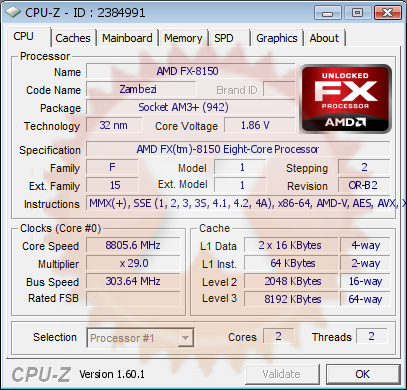AMD FX-8150 Breaks New Clock Speed Record at 8.8 GHz
An overclocker going by the name ksin claims to have hit a new record clock for AMD's Bulldozer CPU.
A clock speed of 8,805.64 MHz appears to be a new record for the processor. The most recent record was 8,584.8 MHz, set back in November of last year.
Like the previous record holder Andre Young, ksin also used a Asus Crosshair V Formula motherboard and only two cores were active during the test run. The core voltage was lower at 1.86 volts versus 2.076 volts, but ksin used a significantly higher base clock of 303.64 MHz with a 29x multiplier versus the 276.9 MHz and a 31x multiplier applied by Young.
There was no further information on the system such as cooling techniques used. However, if the submission is accurate, there is enough reason to believe that Bulldozer can still add a few more MHz.
Get Tom's Hardware's best news and in-depth reviews, straight to your inbox.

Douglas Perry was a freelance writer for Tom's Hardware covering semiconductors, storage technology, quantum computing, and processor power delivery. He has authored several books and is currently an editor for The Oregonian/OregonLive.
-
scook9 Did they learn nothing from Intel's NetBurst days?Reply
A stock cooled IB i7 is still faster than this.....(so around 4.5GHz) -
subasteve5800 We get it. If you disable most of the chip and submerge the rest in LN2, you can achieve a ridiculously high overclock. It's completely unrealistic and useless, but you can do it.Reply
When you get an FX chip (with all cores enabled) running at 8.8 GHz and it can run Prime95 for 24 hours, I'll be impressed. -
bawchicawawa darkenmoon97How do we know it's stable?Reply
You're new to suicide overclocking, aren't you?
-
redyellowblueblast I use a AMD-FX machine with Linux on it and I don't see any of the performance problems that I did on Windows 7. Which leads me top believe that the problem is more with Windows 7 not understanding the BD architecture, and not the architecture itself. The Linux kernel seems to be better suited at the moment at understanding the chip. Hopefully Windows 8 will fix it. (that is if Windows 8 will even be worth it.) And I'm still waiting on my Piledriver upgrade, AMD!Reply -
jryan388 @subasteve5800 it's prolly liquid helium; I think they use ln2 initially and then after it's at n2 boiling point switch to helium which has a much lower boiling point (something like 4k)Reply
